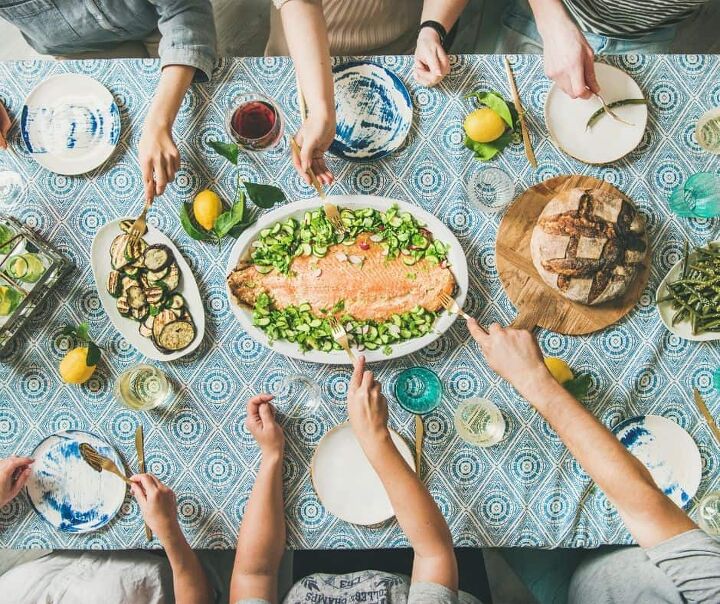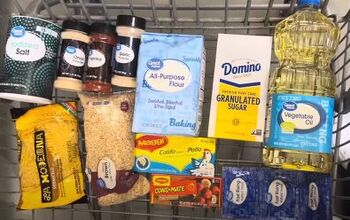6 Grocery Shopping Tips to Feed a Family of 5 on a $100 Budget

When I first started buying groceries for a family of 5 I was dropping $500 in the first-week grocery shopping. Not a good idea when you’re a stay at home mom and your husband only gets paid once a month. No sir, no it’s not. Looking back I can tell a few major things that got in my way:
- Got swept away with “super foods”
- Shopped too much in bulk
- Bought whatever I wanted
- Overly concerned with the healthiest options
Now it’s crazy to me after getting my shopping addiction under control and living on a budget how we are spending only $100 on groceries for a family of 5. I swear it’s possible to not only feed everyone, but eat healthy too! Here’s how we made it happen.
*This post contains affiliate links through which I may make a commission. All thoughts and opinions are my own.
Planning your budget
My absolute best tip for sticking to a grocery budget, especially if you are feeding a large family is to plan a budget and stick to it! A lot of times people will create super tight budgets that they really want to live up to. However, these super strict budgets often leave you failing month after month. How to Set up a Spending Plan That Sticks
Shop your pantry first
Before you even get to the grocery store, take a look at the food that you already have in your cupboards and refrigerator! This is the best way to prevent over-shopping and over-spending.
Shopping your pantry will give you an idea of what meals you could make for the week and helps reduce the number of items you add to your grocery list. Another great option, if you are not great at planning meals, is to look into $5 Meal Plans. These are meal plans created by a busy, mother of 4, designed to help you stay healthy and stick to a budget. You get meal plans as well as a complete grocery list and you can get customized ones depending on your dietary restrictions!
5 tips for shopping your pantry
- Check your starches first – Do you have items like rice, noodles or potatoes? These items can be the building blocks of meals and can require very little ingredients!
- What proteins do you have left? If you have some proteins like chicken or beef left in your fridge, you may be able to come up with a stir fry or pasta dish to go along with rice or noodles you may have found.
- Check the frozen stock – Keeping frozen fruits and veggies stocked is another way our family of 5 reduces our grocery costs. Because frozen fruits and veggies don’t go bad as quickly, they last longer throughout the month.
- What fresh foods could you use? Now check for easy-grab healthy snacks like apples, bananas, or carrot sticks. Remember you don’t need all these things. If you still have some left from before make sure to make a note on your grocery list so you don’t over-stock.
- Now what do you need? After checking these 4 areas, you should be able to come up with some idea of what breakfast, lunches, and dinners you may be able to come up with. NOW is when you create your grocery list by adding to what you already have.
Shop in season
It is crazy how much I let my obsession with strawberries held me back for so long. I know I can’t be the only one!
Whether strawberries were $2 or $6, I would buy them! I would buy a lot of them!
Cheaper, healthier and lasts longer!
Not only is shopping in season a big money saver but it also means there is less handling and traveling for your produce! That means there is less likelihood of contamination and lowers the chances of far travel for your food.
Why would travel time matter?
If you consider that your food has been picked and then takes even longer to get to you, there is a better chance it is going to spoil sooner (and cost you more)!
In season = trying new foods
Now I find myself branching out in the grocery stores.
Instead of always going for the berries, our family eats things like pears and pomegranates in the winter.
How do I know what’s in season?
When I first heard about the concept of grocery shopping for what was in season, I was totally overwhelmed.
How in the world was I supposed to know what was in season and what wasn’t?
I tried to study charts and remember when I got to the store but it all became too much. Well, I’m about to drop a truth bomb for ya’ll.
BASIC IN-SEASON RULE: If it’s cheaper…it’s in season. Boom! Easy as that!
Oh, and avocados and apples are a free for all. They are good all year round.
You don’t have to go organic
Like I said, one of my biggest mistakes when starting to eat a healthier diet was that I thought it all had to be organic. So much so that I bought whatever was organic without even looking at the ingredients!
Just because it’s organic, doesn’t mean it’s something you should be consuming on a daily basis. A lot of organic foods are still heavily processed which isn’t a good idea if you are trying to get healthy groceries for a family of 5! You can get customized meal plans based on your needs at the $5 Meal Plan.
Organic/non-organic swaps
Beyond avoiding processed foods, there are a few swaps you can make from organic to non-organic if you are trying to shop on a budget. Here are a few of the little swaps we have done.
Organic eggs for eating and non-organic for baking
In the stores, non-organic eggs are generally 1/4 the cost of organic eggs. You can also save a ton by shopping in bulk at Costco. The price of 2 dozen eggs is similar to the cost of 1 dozen at most other grocery stores.
Buy “protected” non-organic fruits and vegetables.
There are veggies known as “the dirty dozen” that are the most filled with pesticides when they aren’t organic.
Reading about these was similar to in-season produce for me; it was too hard to remember all the details.
Then I realized how easy it was. Basically, if your produce is “protected” like pineapple, mangos, bananas and melons it’s a safer bet than those that aren’t.
Avoid organic “junk food”
There is a good chance you aren’t saving yourself much “health” by buying an organic pizza for $8 versus a non-organic one for $2. A basic rule for our family of 5 is, if we’re eating junky, we’re not going to waste too much money on it!
Related Posts
- 5 Minute Healthy Dinner Hacks
- $100 Organic Costco Shopping List
- 30 Healthy Meals to Make in a Hotel Room
Cut back on protein
People are consuming far more protein than necessary these days, especially when it comes to animal proteins.
Things like meat and cheese are things our family has majorly cut back on in order to get right with our health and our budget. I know not everyone consumes animal proteins, but this could easily go for vegan cheeses, beans, lentils and tofu as well.
- Cut back on the cheese.
- We have found ways to add additional flavors into our meals so that we aren’t using dairy heavy products like cheese or cream as the main flavor source.
- Spread out the meat (or beans)
- Create burgers with wild rice – this is especially great for meal prepping and it adds additional flavor.
- Combine your proteins with large stir-fries of vegetables – this makes a little bit go a long way.
- Create pasta dishes, stews or chowder – you can feed an entire family for 2 days with 2 chicken breasts if you toss in some noodles, veggies, and broth!
5 Frugal Meals to Make with One Turkey
Shop with intention
A lot of people tend to head to the store looking for sales or discount items, my biggest recommendation is to shop with intention. When you get to understand your own habits (and how stores are marketing to you), it gets easier and easier to avoid the temptation of sales tactics and discounts (including coupons!) Check out The Shopaholic Solution to learn more.
Here are some guidelines to help you shop a little smarter and save more:
- Shop your pantry
- Get your items
- Check for discounts (don’t base your shopping off what’s on sale), I use Ibotta to get money back on what I would already purchase anyway
- If you struggle with overspending, consider investing in a shopping service. Even though there is a fee, I signed up for the Instacart membership for $99 (It’s cheaper than my yearly Costco membership and even when tipping, I KNOW I save money by avoiding all the “extras” I would toss in the cart.)
Plan your savings
After you’ve gone through all of these steps, you can get all of your groceries and rebates organized. This will ensure that you can stick to your budget and take advantage of all of your savings. There are great printouts in the Fun Sized Budget Bundle designed to help you keep all of this organized.
Shop bulk for things you eat a lot
Bulk shopping can be people’s mortal enemy simply because they get carried away and buy everything.
Instead, if you have a bulk buy membership like Costco or Sam’s Club, get a strategy down for buying bulk items that you use a lot of. And remember, you can save yourself the temptation by getting an Instacart membership. This can help you stay on budget and get avoid spending an hour or more navigating Costco!
Great things to buy in bulk:
- Oats or cereal (especially for a family of 5!)
- Proteins like chicken, beef, and seafood
- Eggs
- Frozen fruits and veggies
- Bread, noodles or rice
- Quick grab snack packs for kids
Buying things in bulk (especially items that won’t go bad quickly) is a great way to keep your food supply up and save yourself a ton of money!
Pin this!

























Comments
Join the conversation
My dad was in the Army and until 1973, was paid once a month. Mom went to the commissary the day after payday and bought all the non-perishable stuff as well as things that went into the freezer. Then she kept a certain amount of her food budget for things like milk, bread, ice cream and fresh produce. It worked.
I still do my grocery shopping the same way. Even when I was working and getting paid twice a month, I did the major grocery shopping at the beginning of the month. I'm retired now and getting paid once a month. It's just so much easier than weekly shopping.
In our house we have restricted diet due to all ergies. All dairy eggs cheese are out.gluten is out for half of us. seafood, oats ,cherries, peanuts, yeast, carrots and yams are one person's. Tomatoes and chocolate are another's.Pork is another's.
We live on chicken and Turkey with some beef. Fresh fruit and vegetables are great but cake cookies etc have to be homemade. Egg alternative. Wheat free flour are not cheap
Then we have other salt gelatin are the big ones. We grow things at home to save money.